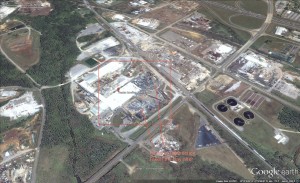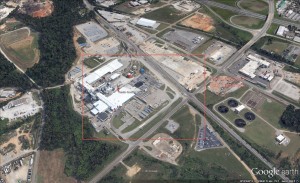TAMKO Roofing Products is a manufacturing company specializing in the production of roofing, decking and cementing materials for both residential and industrial use. The company was founded in Joplin, Missouri, in 1944 and quickly became a profitable business that had to build manufacturing plants in the southern states to keep up with the demand for its products (3).TAMKO built its Tuscaloosa manufacturing plant in 1975, which was the first and only plant to produce the Heritage line of shingles, still to this day TAMKO’s most popular product (4). The site of the plant was carefully chosen because of the resources and transportation available in Tuscaloosa. The Black Warrior River not only provided water for the plant but could be used in conjunction with the already present railroads to ensure materials and products arrived or departed in a timely manner. Other valuable resources such as oil, stone and natural gases are present in Tuscaloosa and could be used in the manufacturing processes (5). Another potential reason that TAMKO chose Tuscaloosa could be the demographics of the city during the time of construction. According to the U.S. Census and Tuscaloosa County records, in 1975 43 percent of the town’s population reported having a high school diploma as the highest level of education they had received and 39 percent of the population listed an income below $10,000 annually (5). The area’s need for more income along with the fact new employees would require minimal training (performing one task continuously on an assembly line) made it possible for the company to hire employees at low wages.
Since its opening, TAMKO has proven to be an economically beneficial business for this community. The company has consistently retained the same number of employees, 185, for the last ten years which has been helpful in keeping unemployment rates lower during this recession and creating a sense of reliability for the company. The business is also extremely profitable, bringing in over $55,659,000 in sales with low production costs in 2012 alone while its competitor ABH Roofing only brought in $2, 902, 000 (1). Since this is the only TAMKO plant that produces the company’s most profitable product, it has been continuously upgraded and expanded over the years to increase production and efficiency (3). These expansions involved hiring contractors and other laborers which fed even more money back into the Tuscaloosa economy. After the tornados that struck Tuscaloosa on April 27,2011, the plant had to stop manufacturing all products due to the loss of two assembly lines and a warehouse full of inventory(2)(see image below). The company rushed to reopen the plant and hired 65 local construction workers and electricians to repair the damage. TAMKO was able to give back to the community by providing work shortly after many lost their jobs and by donating $250,000 to the tornado relief efforts. The Tuscaloosa plant reopened almost a month ahead of schedule on May 25, 2011 and is in operation today (2).
While TAMKO has shown itself to be economically favorable to Tuscaloosa, its environmental impact hasn’t been as beneficial. The EPA has continuously found TAMKO products to be in non-compliance with the Clean Water Act for the last 12 quarters; that means since June of 2011 TAMKO has not been able to resolve an issue with introducing waste into their watershed or public water systems. Some of the materials listed as waste include zinc compounds, chemically oxidized solids, and lead (7). Despite this reported waste, TAMKO claims that their company is environmentally conscious and the corporate website has a video on the environmental issues page that specifically addresses pollution in watersheds. (See http://www.tamko.com/videos/watershed.html). Another issue with this company is the amount of waste being released into the air such as formaldehyde, benzo-perylene, and polycyclic aromatic compounds. (6). TAMKO reported a waste of 3,885 pounds of formaldehyde in 2007 and the area surrounding the plant has been found to be below air quality standards in three separate categories; ozone, lead and particulate matter (7). Perhaps the most shocking of these reports is the Toxin Release Inventory for 2004 in which TAMKO reported a remaining 8,670 pounds of zinc compounds that was not used in production and was not taken to a waste treatment facility. Overall, TAMKO’s biggest environmental problem seems to be the way in which they dispose of materials after the manufacturing process.
Sources:
- OneSource :Reference USA. (2014). TAMKO Roofing Products, Inc. :Business Profile. Retrieved November 2014, from U.S. Businesses .
- TAMKO Building Products,Inc. (2011, June 1). Tusacaloosa Plant Update. Retrieved November 2014, from Media Center.
- TAMKO Building Products,Inc. (n.d.). About Us: The TAMKO Story. Retrieved November 2014
- TAMKO Building Products,Inc. (n.d.). Roofing: 1944-2014. Retrieved November 2014
- The United States Census Bureau. (2014, July 8). Tuscaloosa County, Alabama. Retrieved November 2014, from Census Quickfacts.
- The United States Environmental Protection Agency. (2012). TRI History of Reported Chemicals Released: TAMKO Building Products. Retrieved November 2014, from Environmental Compliance History Online (ECHO).
- The United States Environmental Protection Agency. (2014, September 30). Detailed Facility Report: TAMKO Building Products. Retrieved November 2014, from Environmental Compliance History Online (ECHO).

